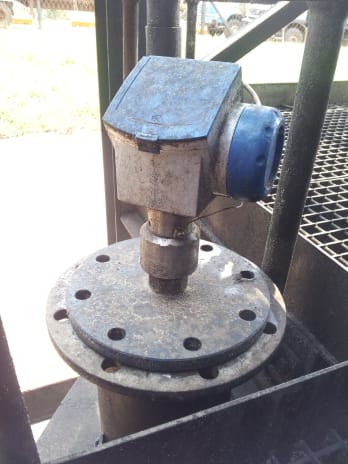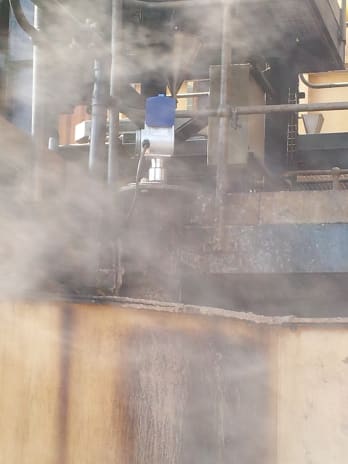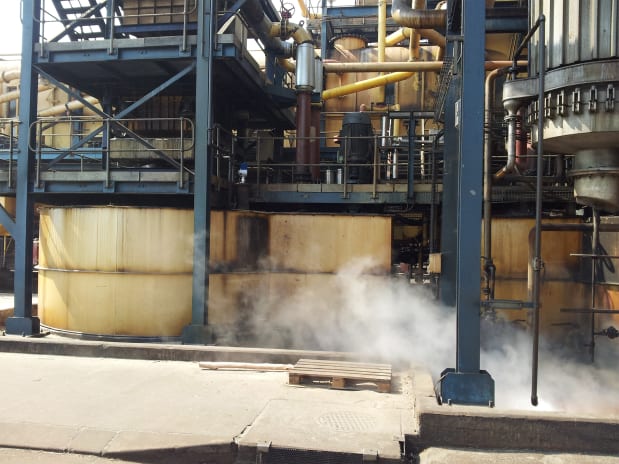Level measurement at sugar cane mill
Application Note | Food & Beverage
- Tanks storing sugar juice for the extraction process
- TDR guided radar measurement in steamy atmosphere with harsh temperature changes
- Output data for an automated supply system

Background
A sugar producer operates a sugar mill in South Africa, where primarily refined and brown sugar is produced from cane juice. During the production process the cane juice is first mixed with lime to convert sucrose into glucose and fructose and to get solid parts to settle. The clarified juice is then taken out and concentrated in a multiple-effect evaporator to make syrup of about 60 percent sucrose by weight. This syrup is further concentrated under vacuum until it becomes supersaturated and then seeded with fine sugar crystals. A sugar centrifuge separates the sugar crystals from the mother liquor. The extracted sugar is finally cooled, dried and packed for delivery.
Measurement requirements
Before the sugar is extracted from sugar water, the sugar juice squeezed out of the sugar cane is stored in two 6.7 m / 22 ft high tanks. In order to record the stock and to prevent the tanks from overfilling, the level of these tanks must be continuously monitored. Up until recently, the sugar plant operator had used an automated system, integrating an ultrasonic level meter, to control the amount of sugar solution fed into the process. However, this device didn’t produce stable measuring results due to the impact of steam from the adjacent separation and evaporation facilities as well as to extreme temperature changes reaching from 40 °C / 104 °F during the day to less than 8 °C / 46.4 °F at night. This caused the sugar producer to temporarily abandon his automated system and to run manually again. Therefore, the company started searching for a reliable and accurate level solution that was up to the challenge of the difficult parameters and suitable for an automated stock management.
KROHNE Solution
The OPTIFLEX 1300 C was the instrument of choice for this application. Two units of this TDR guided radar level meter with 1 ½" process connection were installed on still wells of the two sugar juice tanks. As the sugar manufacturer uses a cathodic protection to stop corrosion, the KROHNE level devices were mounted with nylon flanges (DN 250 / 10”).
Although the TDR (Time Domain Reflectometry) principle relies on the dielectric constant of the medium, the meters are not affected by variations in product characteristics: Fitted on the tank roof, the meter transmits low-intensity electromagnetic pulses along its cable probe. These pulses move at the speed of light. When the pulses reach the surface of the sugar solution, they are reflected with an intensity that depends on the dielectric constant (εr) of the medium. The OPTIFLEX measures the time between emission and reception of the pulse: half of this time is equivalent to the distance from the reference point of the device to the surface of the sugar juice. The time value is converted into a current output of 4…20 mA and/or a digital signal and transmitted to the control room.
Customer benefits
The OPTIFLEX 1300 C enables the sugar producer to run an automated supply system again and to record the stock accurately. With the help of the KROHNE level meter, the customer also prevents the tanks from overfilling. Even though there are severe temperature changes and the work environment of the instrument can be very steamy, the OPTIFLEX always produces stable measuring results.
The level meter's installation wizard allowed the customer to quickly configure the device and to suit the specific installation in the still well which helped to save time and made the instrument ready for use within in a short period of time. For the sugar company the OPTIFLEX is as much a reliable measurement instrument as a maintenance-free solution.






